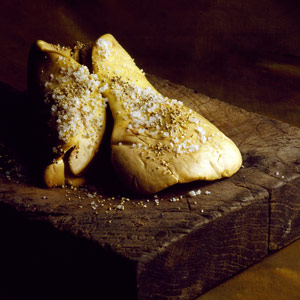Brad Ball is the executive chef at Steenburg’s Bistro Sixteen8 in the Constantia winelands, Cape Town.
Bistro Sixteen8 serves top end bistro-style food with beautiful wine in a striking setting.
I recently enjoyed what I call ‘the fine dining burger’, Brad’s Steenburger, which is served only on Fridays and left me the happiest I had ever been after devouring the so-called fast food.
It’s most controversial ingredient? A beautiful slab of perfectly cooked foie gras.
It is melt-in-the-mouth soft with perfect flavour and it’s most redeeming quality is that the geese were not harmed in any way.
‘What!’ I hear you all shout, ‘Rubbish, fiddlesticks, they’ve all been force-fed and we’re all going to be punished at the pearly gates.’
Not so dear readers, not so. See a short q & a with Chef Brad Ball.
Q: Is the duck liver you use on
your fine dining burger a local product?
A: Yes, it
comes from a farm north of Gauteng.
Q: Are the animals harmed in any
way?
A: The Foie Gras that I use is from a local producer. They are committed to the highest standards of animal welfare. The owners are passionate about the ducks being happy and well looked after.
The ducks are allowed to roam free range where they have access to all natural food and water.
During the final two weeks, before they fly south for the winter, they are fed twice a day, this is known as gavage.
Ducks are a migratory bird and will naturally gorge before flying south for the winter to store fat in the liver and under the skin.
What we are trying to achieve here is a liver that is not 8-10 times its normal size (the usual harmful method of overfeeding), but 3-4 times its size which is about the same as it would do naturally.
Ducks do not have a gag reflex, and are opposed to holding food in their stomach to digest it, ducks keep it in their oesophagus while it is digested. The duck’s oesophagus, like any water fowl is expandable and pliable which allows it to swallow large fish and so the feeding process is not harmful.
Q: Why is it important to you to
serve foie that is ‘green’, why not just use the usual overfed product?
A: When using a product with a controversial nature, I think you
do need to justify why you use it when there are so many poor animal husbandry
methods being used.
I love foie gras and will always
serve it so long as I know the farmer is doing their bit. These geese and ducks
are only fed as much as they would gorge on if they were getting ready for
migration.
Q: Do you think there is a
difference in flavour?
A: I was doing a tasting with my staff
a few weeks ago and made a comment that this local liver is as good in flavour,
but perhaps better in texture.
Q: Do many people still refuse to
eat it, even when they know the animals haven’t been mistreated?
A: I have not had one refusal with
regards to foie at the Bistro and I believe it’s because I try to educate my
patrons about what they’re eating.
Q: Do some people change their
minds once they know the animals have been treated humanely?
A: Not always, but most times people will at least give it a go.

